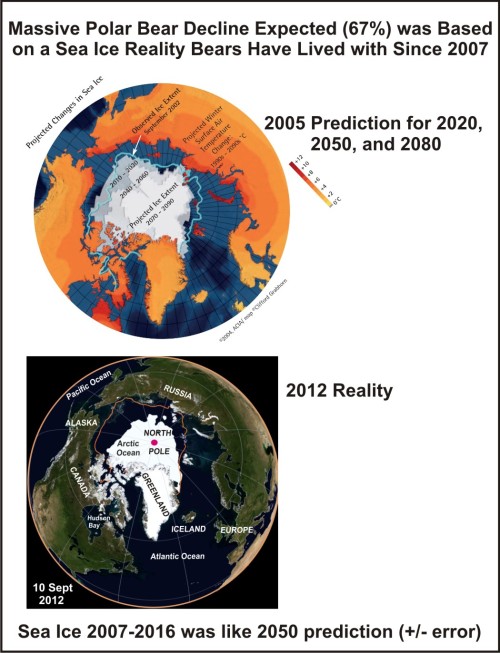I call this fake news because it’s not news – media headlines around the world today (New York Times, Washington Post, DailyMail) are trumpeting the release of a final version of a draft report released with similar fanfare more than a year ago, announced today by the US Fish & Wildlife Service in the official US government publication, Federal Register.

“Without action on climate change, say goodbye to polar bears” is exactly the kind of sensationalized nonsense I address in my new detailed science book, Polar Bears: Outstanding Survivors of Climate Change (announced here, discussed here).

What the USFWS don’t tell the citizens that pay their salaries (in their Conservation Management Plan or their discussions with the press), is that since 2007 (see images above), summer sea ice coverage has declined to levels their sea ice colleagues said would not occur until 2050 yet 2/3 of the world’s polar bears did not disappear as USGS biolgists predicted (which is what got the bears listed as ‘threatened’ under the ESA). They also don’t tell folks that the recent decline in population size recorded for the Southern Beaufort Sea was caused by thick spring sea ice in 2004-2006, not reduced summer sea ice.
Perhaps it’s not a coincidence that this old hype is being recycled as ‘news’ prior to the inauguration of President-elect Trump? I surmise this based on the New York Times take, which includes this passage:
“Mr. Trump has signaled his intention to withdraw the United States from the Paris climate agreement — an accord the wildlife agency lauded in its report as a positive step toward ensuring the continued existence of polar bears — and he has shown little interest in making emissions reduction a priority. Nor is the price tag that accompanies the recovery plan for the polar bear, about $13 million a year, likely to be greeted with enthusiasm by a Republican-dominated Congress that includes members with no great love for the Endangered Species Act.”
If there is much of substance in this document (pdf here) that differs from the draft (pdf here), it would take a page by page analysis to discover (I discussed an interview with polar bear biologist Mitch Taylor regarding that 2015 draft report here).
However, I see that the Federal Register notice (pg. 2393, pdf here) does quote the 2015 IUCN Red List official global population estimate of 22,000-31,000, also listed several times in the final report (including the executive summary), which is an important addition (since the Red List assessment came out after the draft was published in 2015). Only the Washington Post article quoted the global population number but managed to get it wrong (“Scientists say about 19 populations make up an estimated 25,000 to 31,000 bears”).


